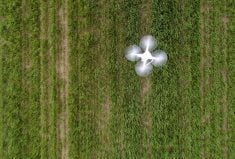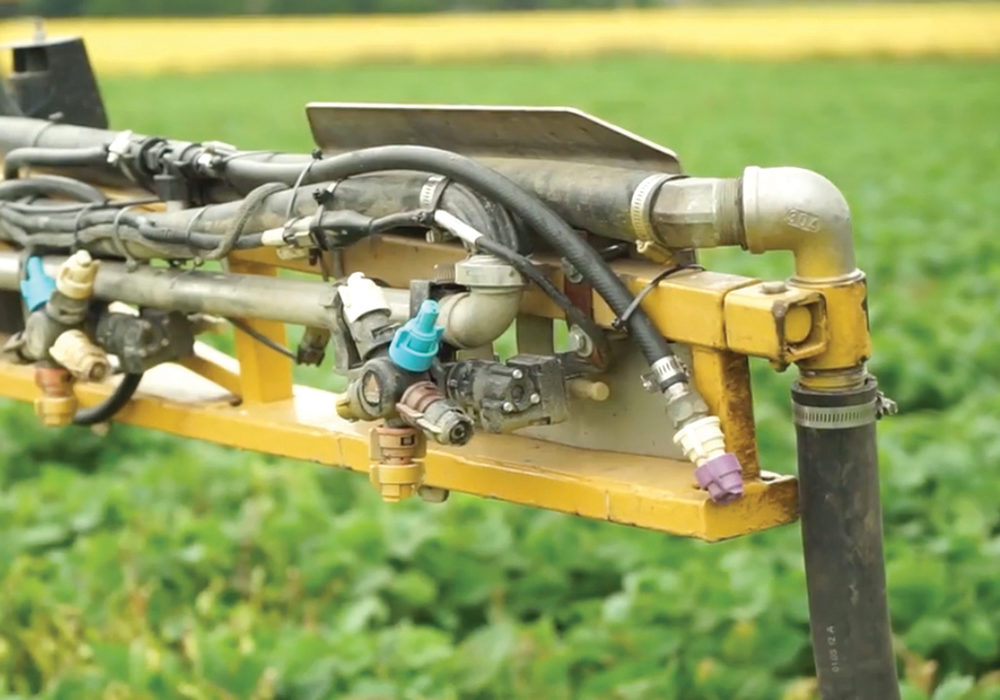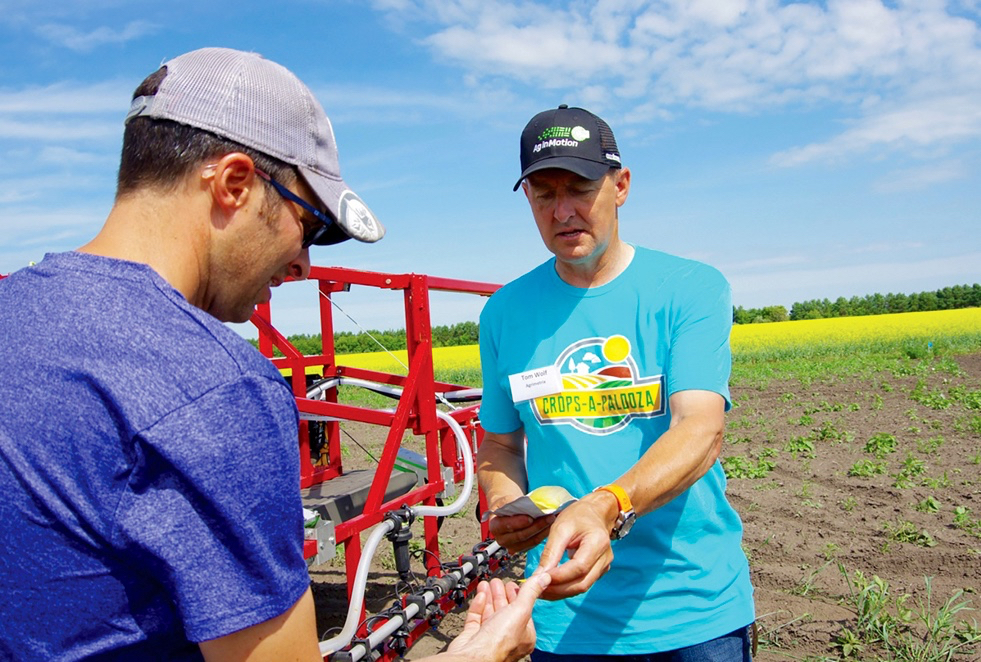Producers have been hearing about weed-targeting spot-spraying sensors for some time, but it’s always seemed to be the stuff of science fiction.
In some cases, however, the future is now while in others it’s coming quickly — it all depends on the type of sensor tech you’re interested in.
Well-known spraying expert Tom Wolf separates precision spot-spraying tech into two categories: ‘green on brown’ and ‘green on green.’
Green-on-brown sensors such as the WEED-IT have been available in Canada for some time and can be used for pre-seed burn-off. Green-on-green sensors which consistently differentiate between crops and weeds are still a little ways away — but not by much, said Wolf.

“I think there is certainly work being done judging by my discussions with some of these (green-on-green) companies,” he said. “They would say the first 80 per cent (accuracy) was a lot easier than the last 20, so they are refining and working on it and it’s just an ongoing process.
“I’m going to quote Yogi Berra: it’s difficult to make predictions, especially about the future.”
A weed-targeting sprayer has two obvious advantages — saving money on herbicide and using less herbicide reduces environmental impacts (such as spray drift floating into water bodies and other at-risk areas).
But from an agronomic point of view, the biggest advantage is delaying the onset of herbicide resistance.
Right now, one of the most powerful tools in the fight against herbicide resistance is mixing multiple effective modes of action in the spray tank. But that’s expensive, said Wolf.
Read Also

Mazergroup’s Bob Mazer dies
Mazergroup’s Bob Mazer, who helped grow his family’s company into a string of farm equipment dealerships and the main dealer for New Holland machinery in Saskatchewan and Manitoba, died July 6 from cancer.
“We broadcast treat (many fields) with glyphosate plus one or two tank mix partners for resistance management,” Wolf said. We could save somewhere between 60 to 80 per cent of that cost by spot spraying them.
“Site-specific technologies like spot spraying make resistance management affordable. I view these technologies as important tools for the preservation of our herbicide capabilities.”
How green on brown works
Put simply, this technology uses ultraviolet light to tell the sensor ‘this plant is green’ and turn on the spray nozzle. That’s not useful for in-crop spraying, but can save big bucks during pre-seed burn-off.
“Users are reporting between 95 and 97 per cent accuracy,” said Wolf.
Although this technology is not new (the WEED-IT, for example, was first released commercially in the Netherlands in 1999), it continues to be researched for its suitability in Western Canada. An upcoming two-year research project by Olds College’s Centre for Innovation will evaluate the latest version of WEED-IT — the Quadro — under Prairie conditions.
The replicated strip trial will collect data from pre-seed herbicide applications on Olds College land in the 2020 and 2021 growing seasons. The scope of the project may be expanded to include post-harvest application and another site (at Lakeland College) pending approval of additional research funds.

“We are specifically looking at the effectiveness of the spot-spraying technology for controlling weeds,” said Joy Agnew, the centre’s director of applied research. “We’re looking at the effect of stubble types, travel velocity and spray settings on spray effectiveness.”
What makes this project different, said Agnew, is that it will help fill in gaps in the existing research on a season-long basis.
“There’s some great information from some of the early adopters about how much chemical use reduction is happening with spot-spray technology. However, no one has been following that through the growing season to see how effective the weed control really is and if there is an effect on yield down the road.
“We are going to map that all the way through to get a true value assessment of the technology’s return on investment,” she said.
Wolf is excited about the potential of the Quadro.
“The sensor has improved. It has a blue light which is more energy efficient and more sensitive. That should facilitate better detection accuracy and maybe even better travel speeds.”
The second aspect which Wolf describes as “very significant” is the Quadro’s addition of a complete pulse width modulation (PWM) capable boom. A PWM system adjusts flow to nozzles individually via pulsing solenoids located at each nozzle.
“The PWM boom is valuable in its own right,” he said. “When you are done sensing in the early spring then you simply use the same boom but turn the sensors off. They’ve merged those two technologies together, which is a significant step.”
Green on green still needs work
The computer algorithms which power green-on-green weed recognition are essentially the same ones which enable facial recognition on your smartphone. And while they’re getting better at recognizing weeds, the technology isn’t quite there yet, said Wolf, adding some European sensors have achieved a good — but not great — accuracy rate of 80 per cent.
“Everyone is being very cautious and the reason is because there has been a high bar set by the performance of herbicides,” he said. “When a producer sprays herbicide for weed control they have come to expect better than 95 per cent results. We can’t afford for anything to escape the herbicide pass.
“If these sensing technologies cannot meet that standard, their commercial success is placed in question. If you are only 80 per cent accurate do you have a product that has any chance of success in the marketplace? Right now I would say the answer is no.”
However, research and innovation in the green-on-green space continues to advance.
Europe is a hotbed for this technology because EU regulations limiting herbicide use for crop production are driving innovation, said Wolf. He got a peek into what European companies are doing at last year’s Agritechnica — the world’s leading trade fair for agricultural technology — in Hanover, Germany.
One such innovation has seen developers flip what the sensors are intended to recognize.
“Some companies have come to realize that identifying every single weed by species is probably a pretty big ask and so they have done something that is the reverse of that,” said Wolf. “They’ve decided to start looking at row crops like corn and have the sensors say, ‘Hey, this is corn and we are 100 per cent sure that it’s corn.’
“If the sensor sees corn it says, ‘That’s safe.’ If it sees something that isn’t corn it says that’s got to be ‘not corn’ therefore it’s probably a weed so it will spray that.
“That approach is what the Xarvio Smart Sprayer will be launched with. It will then eventually, incrementally grow into the kind of row spacings and canopies that can be more difficult.”
Wolf thinks the Xarvio sprayer may become the first green-on-green sprayer tech to be available in Canada, although it may have limited utility in some parts of the Prairies.
“It’s initially going to be a row-crop unit; not so much a Saskatchewan/Alberta product but rather an Eastern Canada, Manitoba and U.S. Corn Belt product.”
Is it worth it?
For most farmers, the biggest question is: How much is it going to cost me and will I save enough on herbicide costs to justify it?
That’s a tough question when it comes to green-on-green tech; however, green on brown is a different story.
According to WEED-IT retailer Croplands Equipment, a 120-foot WEED-IT system will run you about $182,000, not including labour and installation materials. The company claims a producer spraying 8,000 acres per year would recoup that investment in a little over 2-1/2 years.
“That’s a tremendously fast ROI (return on investment),” said Wolf. “That’s driven, of course, by how much you would use it.”
This article was originally published at the Alberta Farmer Express.




















